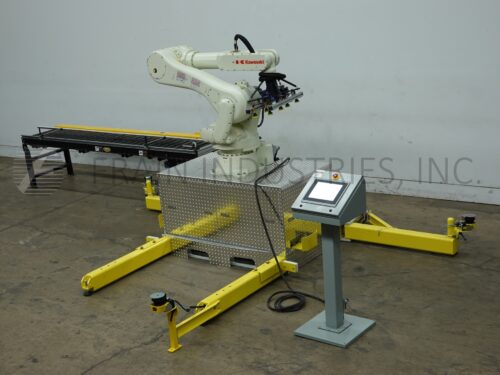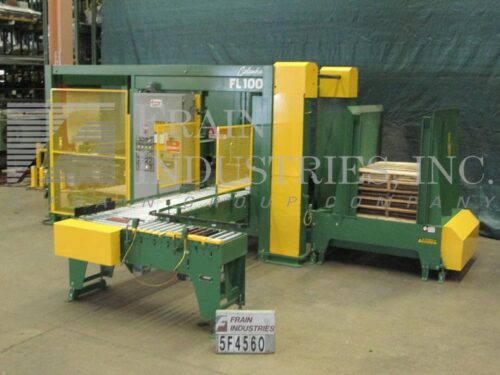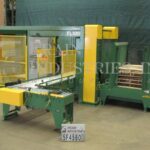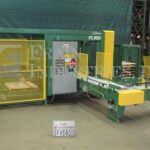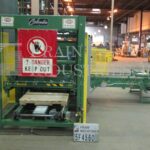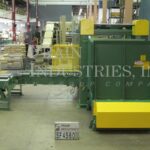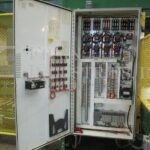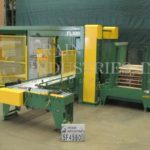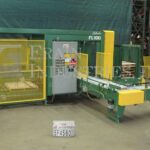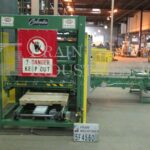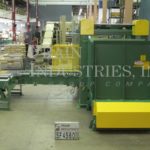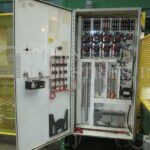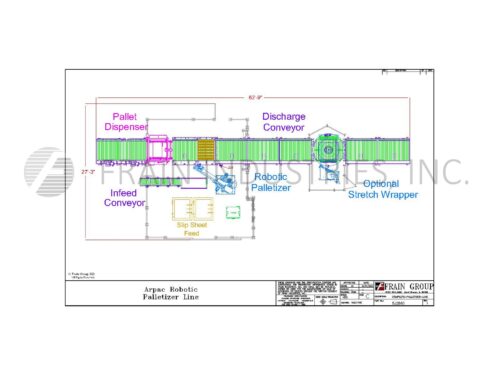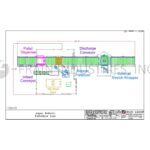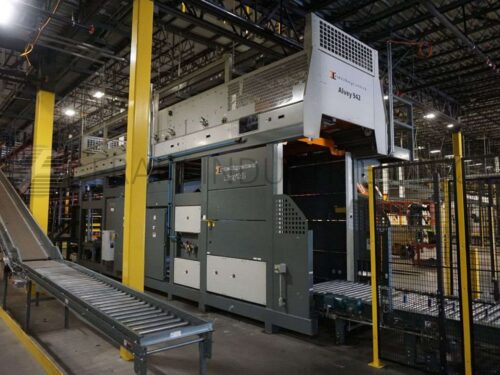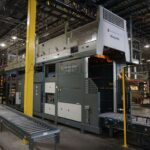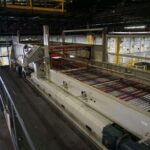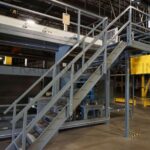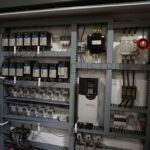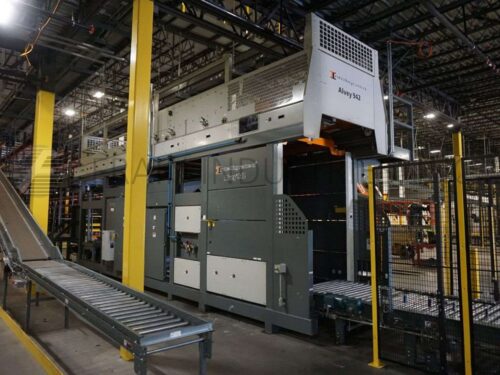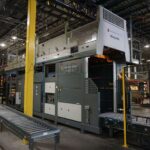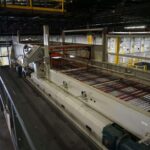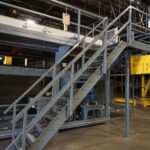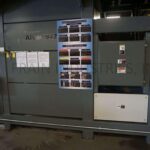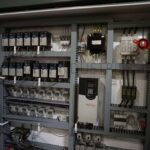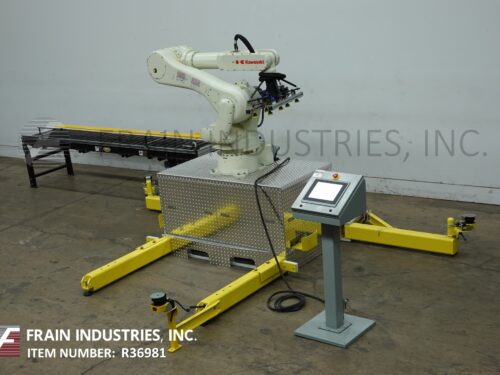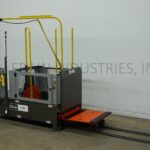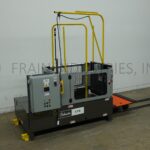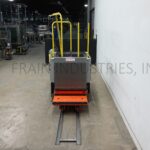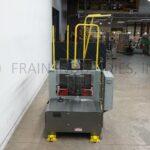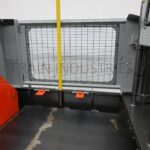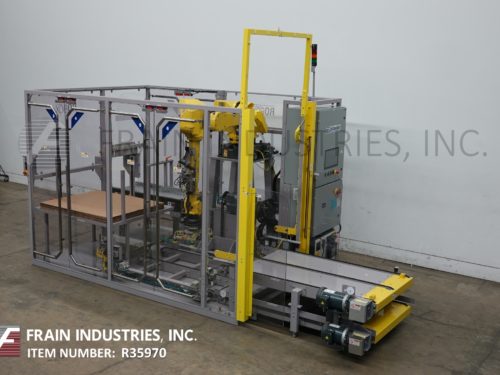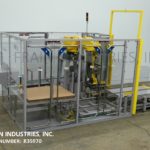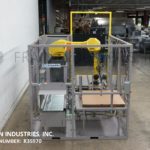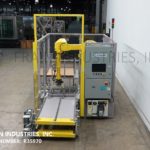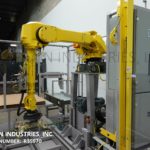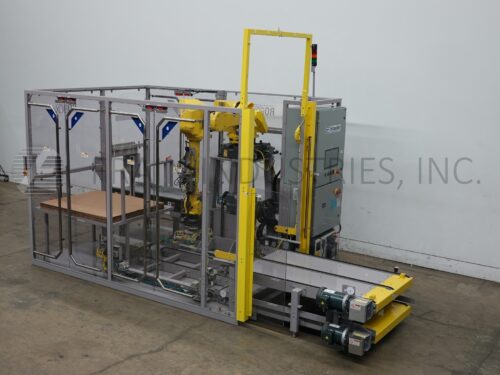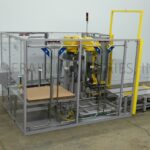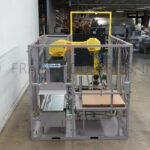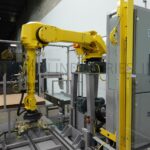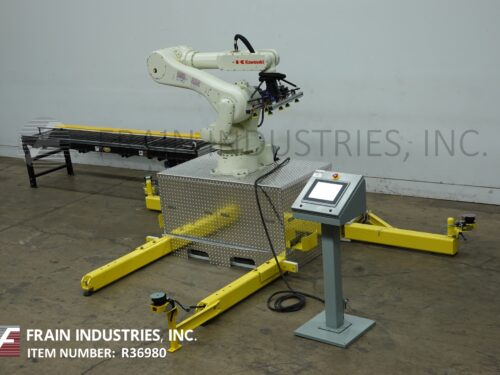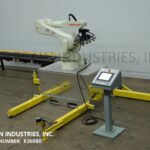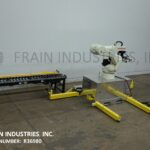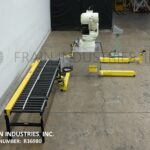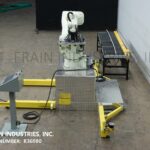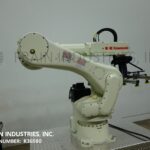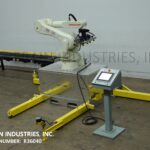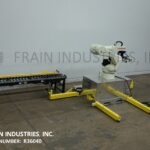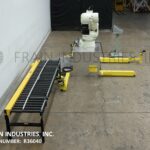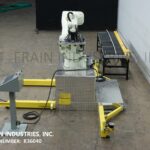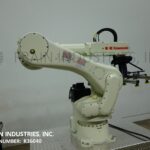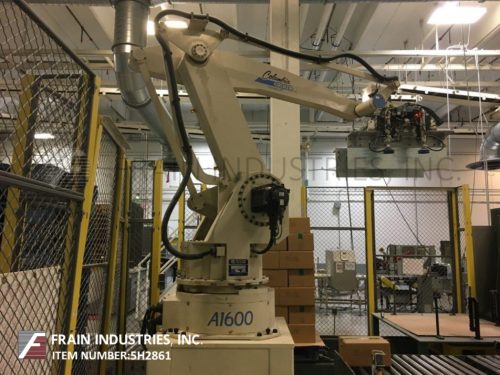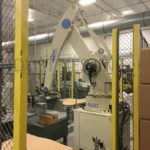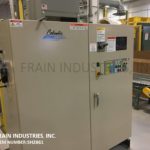Palletizer Machines
Used Palletizer Equipment
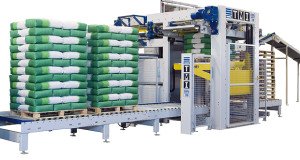 Frain Industries has many palletizers and other end of line packaging equipment and machines from numerous manufacturers in stock and ready to set up for your application. Frain Industries can engineer a palletizing equipment solution and system depending on your application, speed requirements, pack pattern, pack size, footprint, and line integration requirements. Frain has palletizing machine solutions and systems for many applications including: cases, shrink film, display packs, plastic containers, bags, bales, trays, bundles, pails, drums, cans, bottles and many others. We carry several styles of palletizers including:
Frain Industries has many palletizers and other end of line packaging equipment and machines from numerous manufacturers in stock and ready to set up for your application. Frain Industries can engineer a palletizing equipment solution and system depending on your application, speed requirements, pack pattern, pack size, footprint, and line integration requirements. Frain has palletizing machine solutions and systems for many applications including: cases, shrink film, display packs, plastic containers, bags, bales, trays, bundles, pails, drums, cans, bottles and many others. We carry several styles of palletizers including:
- Floor Level Palletizers
- High Level Palletizers
- Robotic Palletizers
Additionally Frain has the ability to integrate palletizer accessories including:
- Load Transfer Equipment
- Pallet Dispensers
- Sheet Dispensers
- Turning Devices
- Pallet Transport Conveyors
Frain Industries carries used palletizers from many OEM manufacturers including: ABB Automation, Adept, Advance Lifts, Allen, Alvey, Automated Production Systems, Busse Brothers, Chatland, Columbia, Currie, FMC, Kinetic, Meridian, Mollers, Ouellette, RMT, Seco, Slidell, Top Tier Inc, Uni-Pak, Von Gal, Whallon and many others.
Related Categories
Palletizer Equipment In Stock
BTB Solutions LLC Palletizer Robotic REAPR
- Manufacturer: BTB Solutions LLC
- Model Number: REAPR
- Frain Number: R37270
BTB Solutions LLC, Model REAPR, (rapidly employed palletizing system) with 6 axis, articulated, rotary joint, robotic, pic-n-place arm. Rated up to 15 cycles per minute with number of product – depending on materials, application, environment, pattern configuration and type of end effector. The system has a Kawasaki RS080N robot arm with 24" long (4) suction cup end effector and has a stack height up to 79" with a maximum reach of 82" and maximum pick-up weight of 160 lbs. Capable of 3 pallet positions. Product infeed roller conveyor is 21" wide x 118" long with 2" diameter rollers set on 3" centers. Control panel has A/B PLC with A/B HMI panelview with step by step setup. (3) 2D area scanners provide 360 degree safety protection with two configurable zones (warning zone – slows the robot’s motion and stop zone – stops all motion). Mounted on heavy duty frame.
OAD:
Robot – 72" L x 67" W x 98" H
Conveyor – 126" L x 26" W x 37" H
Columbia Palletizer Full case FL100
- Manufacturer: Columbia
- Model Number: FL100
- Frain Number: 5F4560
Columbia Model FL100, Low level, full case palletizer rated from 5 to 12 cases per minute and number of pallets per hour – depending on materials and application. Case size range: up to 22" in Length; 16" in Width; 18" in Height. Pallet load capacity: up to 48" in Length; 48" in Width; and 65" in Height with skid and Weight capacity: up to 600 lbs per tier and 3000 lbs per load. Equipped with 12 capacity empty pallet magazine that accommodates pallets from 40" x 40" to 48" x 48", with powered roller case in feed conveyor, orientation and layer former, pallet loading section with pusher bar and discharge conveyor. Control panel has A/B PLC and safety guarding.
Slip Sheet Feeder Available At Additional Cost
OAD: 188" L x 192" W x 120" H Palletizer
80" L x 58" W x 84" H Pallet Magazine
Arpac Palletizer Full case ARBOT1000
- Manufacturer: Arpac
- Model Number: ARBOT1000
- Frain Number: 5J2860
Arpac, Model ARBOT 1000, (4) axes, servo driven, articulated, rotary joint, pic-n-place robotic arm palletizing system. Rated from 10 to 45 pallets per hour with number of product – depending on materials, application, machine configuration and pack pattern. Capable of moving product from floor level up to 119" in height, rated up to maximum pick-up weight of 418 lbs. Equipped with Yaskawa PL190 robotic arm, suction cup vacuum with fork pic-n-place head mounted on robotic arm with 124" maximum horizontal reach and vacuum pump, 50" wide x 48" deep x 64" high pallet magazine, (1) 52" wide x 60" long powered roller conveyor load zone, 18" wide x 60" long product picking conveyor, (2) 45" wide x 52" long slip sheet holders and cage style safety guarding. Control panel with touch screen HMI.
Get a Free Quote Call: 630-629-9900Alvey Palletizer Full case 942
- Manufacturer: Alvey
- Model Number: 942
- Frain Number: 5J2741
Alvey, Model 942, High level, high speed, full case palletizer. Rated up to 160 cases per minute – depending on materials and application. Load size: 40" in Length; 48" in Width; up to 91" in Height. Maximum 500 lbs per layer and up to 4000 lbs per load. Equipped with pallet dispenser, 22" wide case infeed belt, spacer belt, meter belt, long slat divider, bump turner, layer forming area, accumulation area and hoist area. Control panel has AB PLC and touch screen HMI. Mounted on heavy duty frame.
OAD: 647" L x 170" W x 185" H
Get a Free Quote Call: 630-629-9900Alvey Palletizer Full case 942
- Manufacturer: Alvey
- Model Number: 942
- Frain Number: 5J2740
Alvey, Model 942, High level, high speed, full case palletizer. Rated up to 160 cases per minute – depending on materials and application. Load size: 40" in Length; 48" in Width; up to 91" in Height. Maximum 500 lbs per layer and up to 4000 lbs per load. Equipped with pallet dispenser, 22" wide case infeed belt, spacer belt, meter belt, long slat divider, bump turner, layer forming area, accumulation area and hoist area. Control panel has AB PLC and touch screen HMI. Mounted on heavy duty frame.
OAD: 647" L x 170" W x 185" H
Get a Free Quote Call: 630-629-9900BTB Solutions LLC Palletizer Robotic REAPR
- Manufacturer: BTB Solutions LLC
- Model Number: REAPR
- Frain Number: R36981
BTB Solutions LLC, Model REAPR, (rapidly employed palletizing system) with 6 axis, articulated, rotary joint, robotic, pic-n-place arm. The system has a Kawasaki RS080N robot arm with 24" long (4) suction cup end effector and has a stack height up to 79" with a maximum reach of 82" and maximum pick-up weight of 160 lbs. Capable of 3 pallet positions. Product infeed roller conveyor is 22" wide x 118" long with 2" diameter rollers set on 4" centers. Control panel has A/B PLC with A/B HMI panelview with step by step setup. (3) 2D area scanners provide 360 degree safety protection with (2) configurable zones (warning zone – slows the robot’s motion and stop zone – stops all motion). Mounted on heavy duty frame. Rates dependent on materials, application, environment, pattern configuration and type of end effector.
OAD: 74" L x 67" W x 80" H (Robot)
: 123" L x 34" W x 32" H (Conveyor)
Columbia Palletizer LTS-C
- Manufacturer: Columbia
- Model Number: LTS-C
- Frain Number: R37841
Columbia, Model LTS-C, pallet transfer machine with number of pallets per hour – depending on materials and application. Rated up to 4000 lbs load capacity. Equipped with 60" long x 50" wide transfer plate, 48" long x 43" wide pallet cart, pallet upstacker and touch screen HMI with e-stop push button. Designed to transfer product from one pallet to another when inverting is not possible.
OAD: 118" L x 78" W x 130" H (Machine)
115" L x 48" W x 6" H (Track for Pallet Cart)
Schneider Palletizer Robotic ROBOX
- Manufacturer: Schneider
- Model Number: ROBOX
- Frain Number: R35970
Schneider Model Robox, Robotic palletizing system with (5) axis, articulated, rotary joint, servo driven, robotic, pic-n-place arm rated from 1 to 15 cycles per minute with number of product – depending on materials, application, machine configuration and pack pattern. Painted carbon steel construction. Case size range: 6.5" to 22" in length, 4.5" to 16" in width and 3" to 16" in height. Pallet dimensions 48" x 40" x 4.5". Maximum pallet load size: 41" x 48" x 80" and sheet sizes 30" x 30" to 48" x 40" vacuum pickable. with maximum case pick-up weight of 80 lbs. Ambient temperature of 35º F to 100ºF and 95% RH non-condensing. Magazine pallet sheet and layer sheet capable. Fanuc M-7 10iC/50H Robot, with vacuum tooling end arm affector. Over / Under conveyor, has (3000 pound) capacity and 20 second cycle. Double perimeter guard locking doors located along the length of pallet provides operators easy access to pallet and has 80" long infeed conveyor with 30" to 36" infeed height and 0" to 15" discharge height. Control panel has Rockwell Automation Compact GaurdLoix PLC with VersaView 12" touchscreen HMI and statis light bar. UL Compliance, inspection and labeling of main electrical enclosure. Mounted on heavy duty frame.
OAD: 211" L x 97" W x 90" H
Get a Free Quote Call: 630-629-9900Schneider Palletizer Robotic ROBOX
- Manufacturer: Schneider
- Model Number: ROBOX
- Frain Number: R36990
Schneider Model Robox, Robotic palletizing system with (5) axis, articulated, rotary joint, servo driven, robotic, pic-n-place arm rated from 1 to 10 cycles per minute with number of product – depending on materials, application, machine configuration and pack pattern. Painted carbon steel construction. Case size range: 6.5" to 22" in length, 4.5" to 16" in width and 3" to 16" in height. Pallet dimensions 48" x 40" x 4.5". Maximum pallet load size: 41" x 48" x 80" and sheet sizes 30" x 30" to 48" x 40" and vacuum pickable. Maximum pick-up weight of 50 kg. or 110 lbs. Ambient working temperature of 35º F to 100ºF and 95% RH non-condensing. Equipped with pallet sheet magazine, layer sheet capable. Fanuc M-7 10iC/50H Robot has end of arm vacuum tooling end affector. Over / Under conveyor, (3,000 pound) capacity and 20 second cycle time, Double (2) locking doors on perimeter guard located along the length of pallet provides operators easy access to pallet and has 80" long in feed conveyor with 30" to 36" in feed height and 0" to 15" discharge height. Control panel has Rockwell Automation Compact GaurdLoix PLC with VersaView 12" touchscreen HMI and statis light bar. UL Compliance, inspection and labeling of main electrical enclosure. Mounted on heavy duty frame.
Adjustable End-of-Arm Tooling Size range: 10.75 x 7.5″ to 18.25″ to 14.75″ with proper change parts
OAD: 211" L x 97" W x 90" H”
Get a Free Quote Call: 630-629-9900BTB Solutions LLC Palletizer Robotic REAPR
- Manufacturer: BTB Solutions LLC
- Model Number: REAPR
- Frain Number: R36980
BTB Solutions LLC, Model REAPR, (rapidly employed palletizing system) with 6 axis, articulated, rotary joint, robotic, pic-n-place arm. The system has a Kawasaki RS080N robot arm with 24" long (4) suction cup end effector and has a stack height up to 79" with a maximum reach of 82" and maximum pick-up weight of 160 lbs. Capable of 3 pallet positions. Product infeed roller conveyor is 22" wide x 118" long with 2" diameter rollers set on 4" centers. Control panel has A/B PLC with A/B HMI panelview with step by step setup. (3) 2D area scanners provide 360 degree safety protection with (2) configurable zones (warning zone – slows the robot’s motion and stop zone – stops all motion). Mounted on heavy duty frame. Rates dependent on materials, application, environment, pattern configuration and type of end effector.
OAD: 74" L x 67" W x 80" H (Robot)
: 123" L x 34" W x 32" H (Conveyor)
BTB Solutions LLC Palletizer Robotic REAPR
- Manufacturer: BTB Solutions LLC
- Model Number: REAPR
- Frain Number: R36040
BTB Solutions LLC, Model REAPR, (rapidly employed palletizing system) with 6 axis, articulated, rotary joint, robotic, pic-n-place arm. The system has a Kawasaki RS080N robot arm with 24" long (4) suction cup end effector and has a stack height up to 79" with a maximum reach of 82" and maximum pick-up weight of 160 lbs. Capable of 3 pallet positions. Product infeed roller conveyor is 22" wide x 118" long with 2" diameter rollers set on 4" centers. Control panel has A/B PLC with A/B HMI panelview with step by step setup. (3) 2D area scanners provide 360 degree safety protection with (2) configurable zones (warning zone – slows the robot’s motion and stop zone – stops all motion). Mounted on heavy duty frame. Rates dependent on materials, application, environment, pattern configuration and type of end effector.
OAD: 74" L x 67" W x 80" H (Robot)
: 123" L x 34" W x 32" H (Conveyor)
Okura / Columbia Palletizer Robotic A1600
- Manufacturer: Okura / Columbia
- Model Number: A1600
- Frain Number: 5H2861
Okura Model A1600, Single robotic, (4) axis, pick and place palletizer arm, 10′ long product infeed conveyor, pallet dispensor, slip sheet, dual powered roller pallet loading areas. Maximum load capacity of: 140 Kg. Remote control panel has New A/B PLC controller with HMI touch pad controls has main power and motor power on / off with start, stop, e-stop controls. Cage style safety guarding and roller in feed and discharge conveyor sections.
OAD: __" L x __" W x ___" H
Get a Free Quote Call: 630-629-9900
